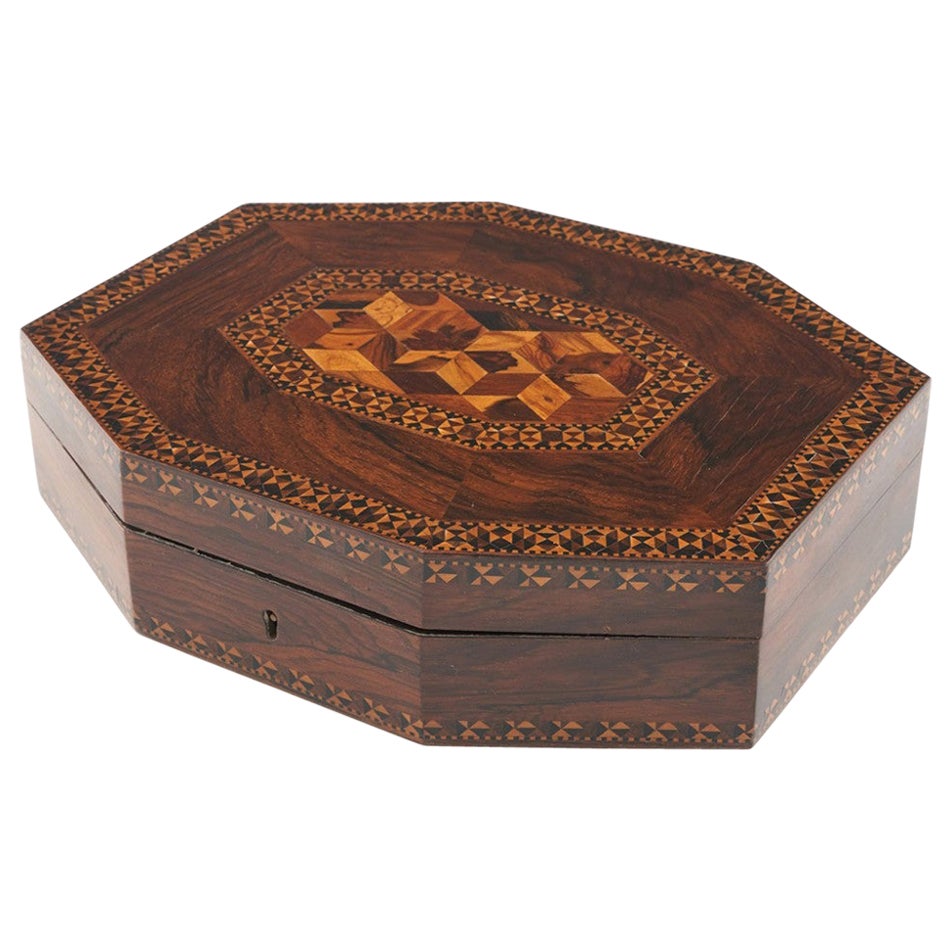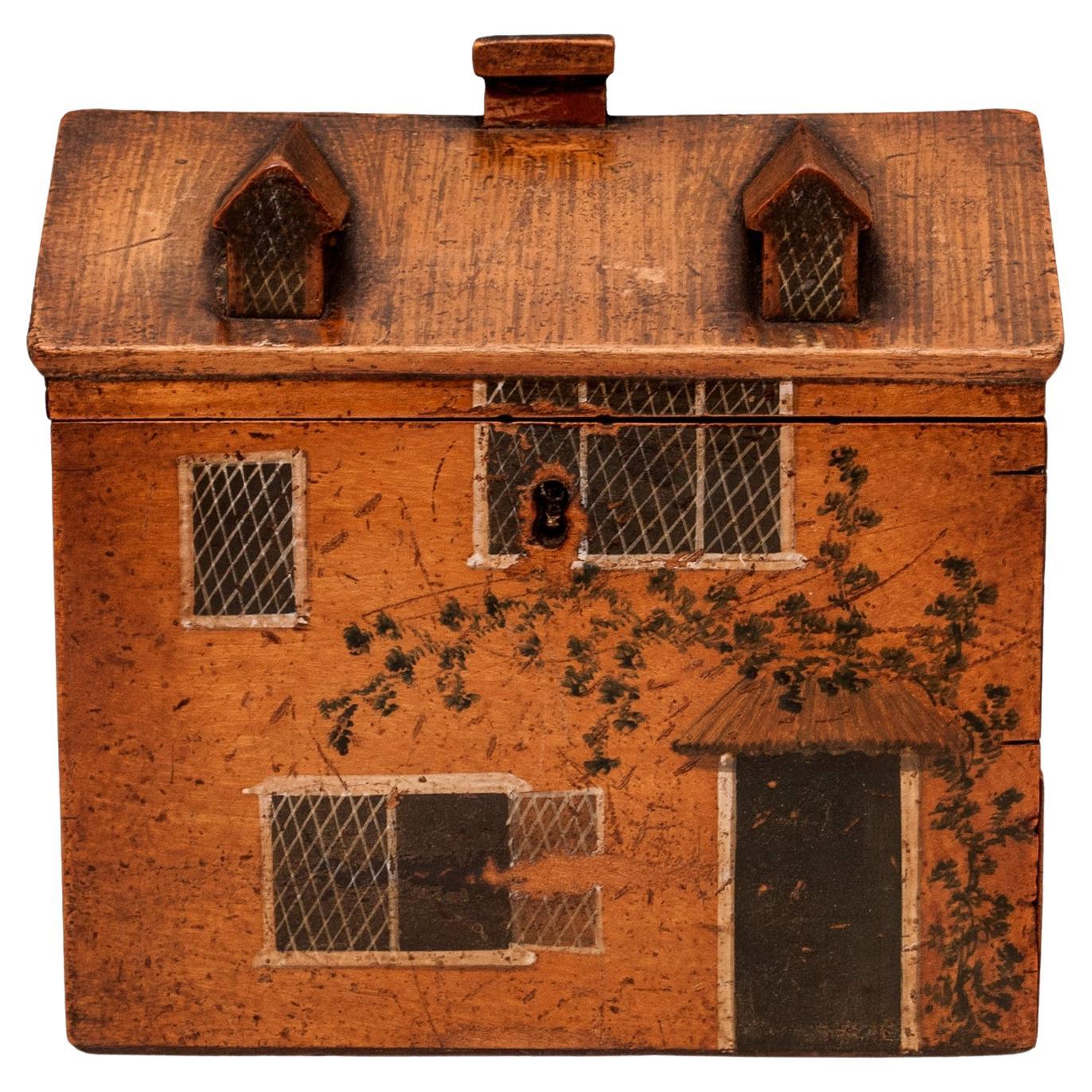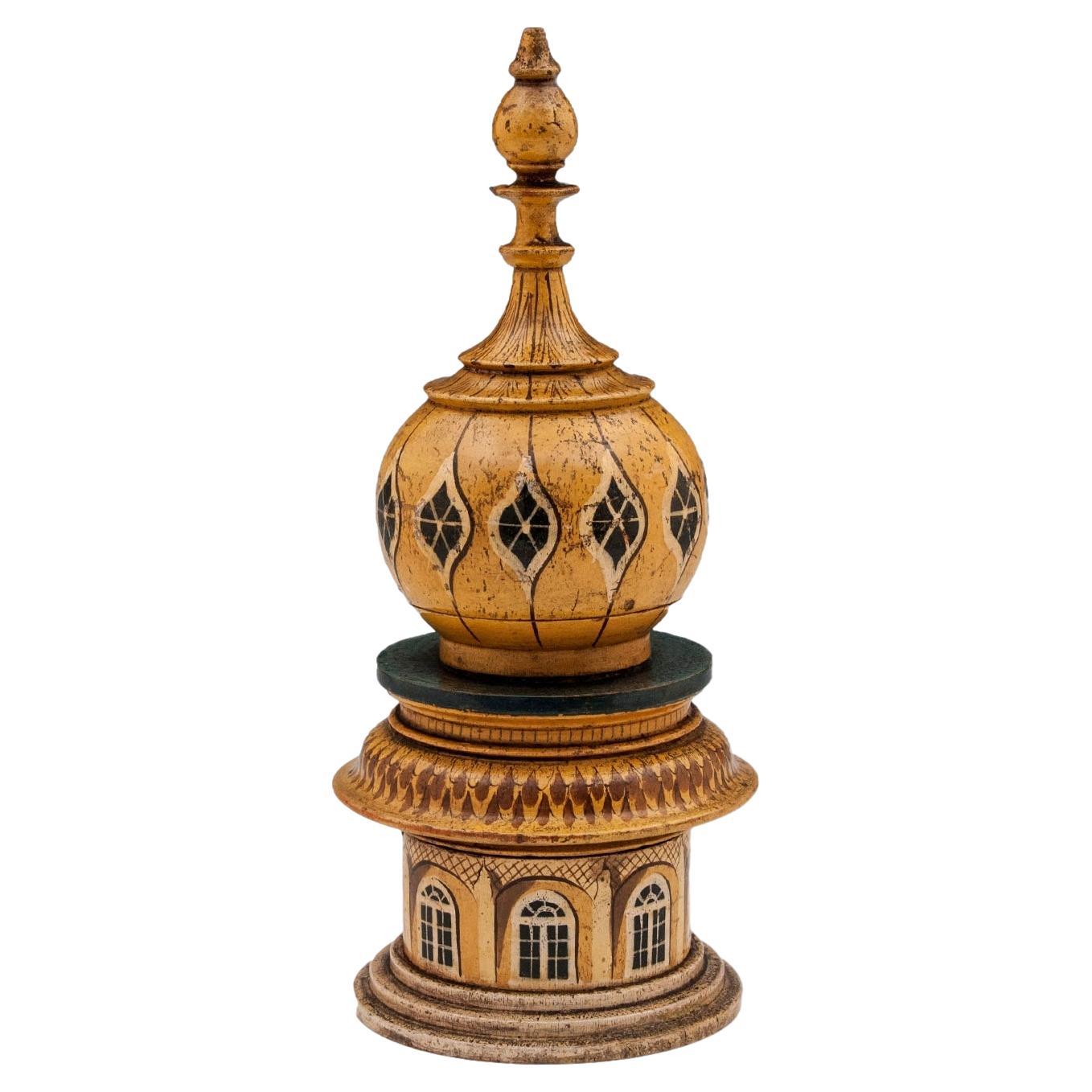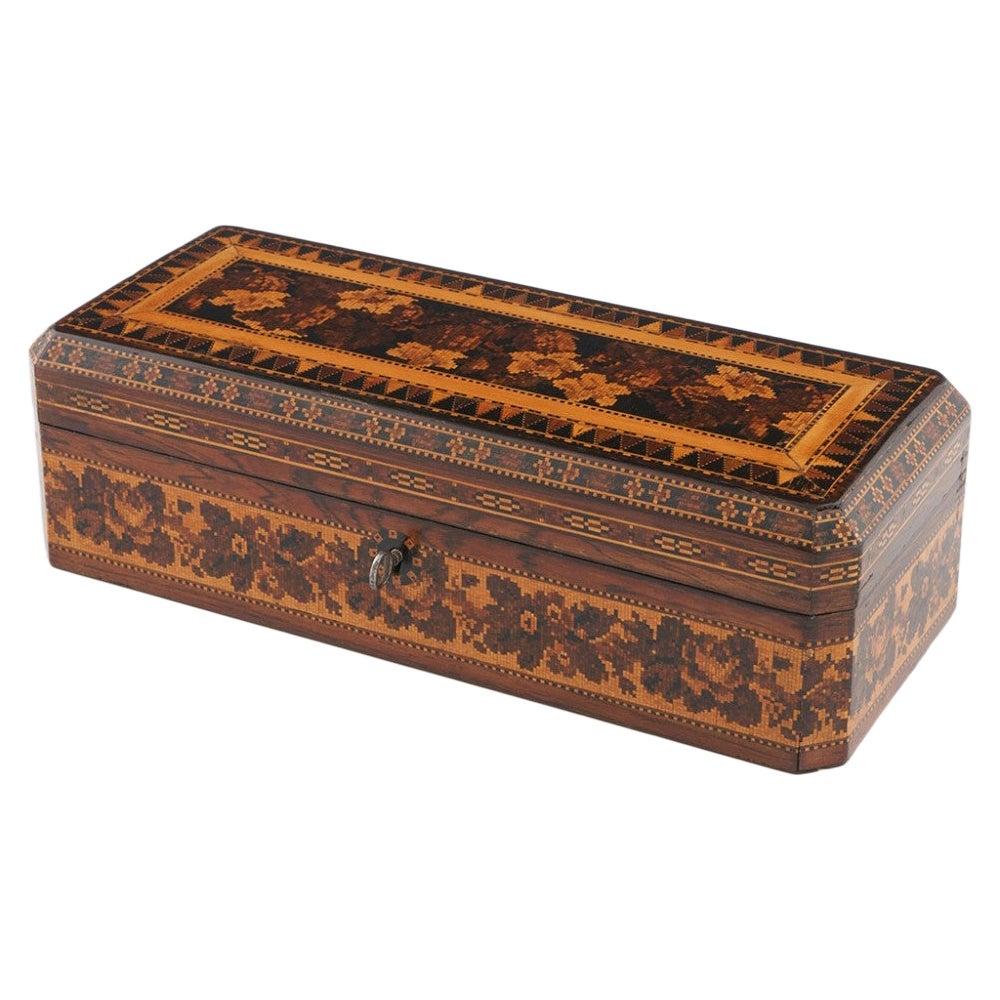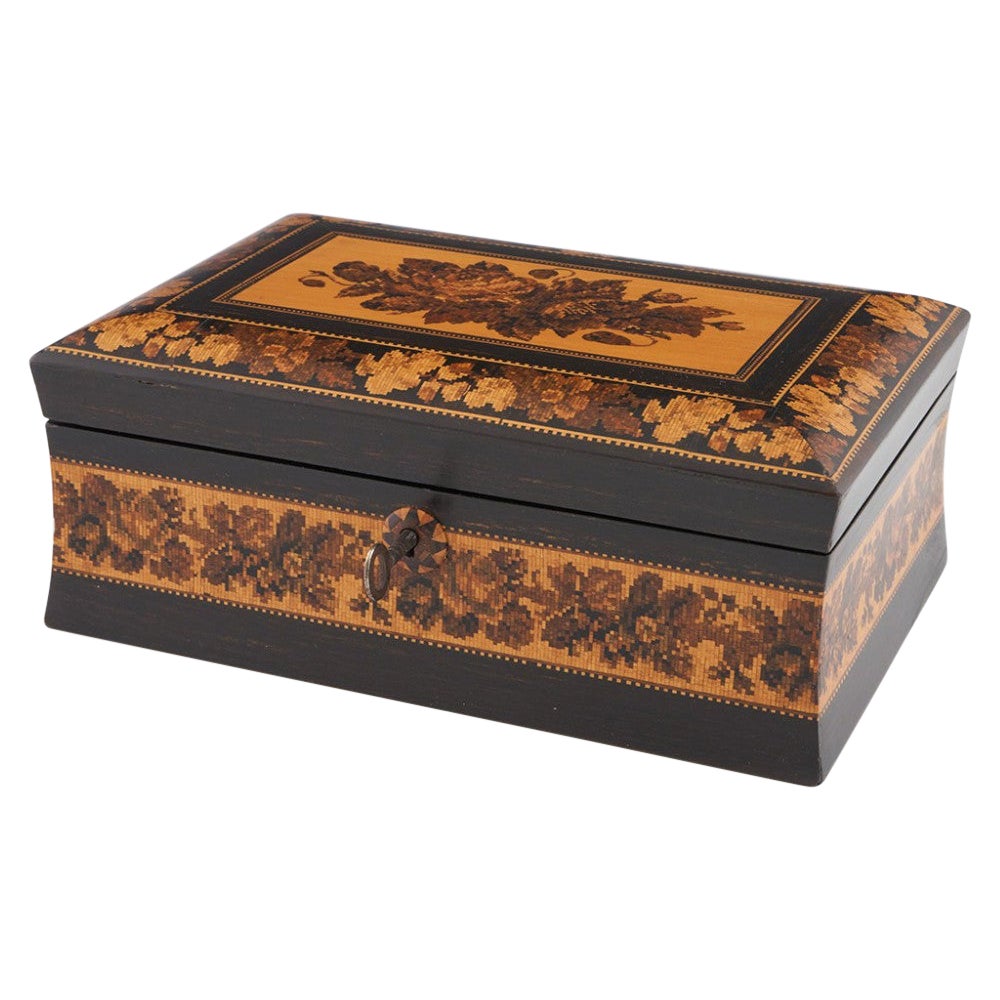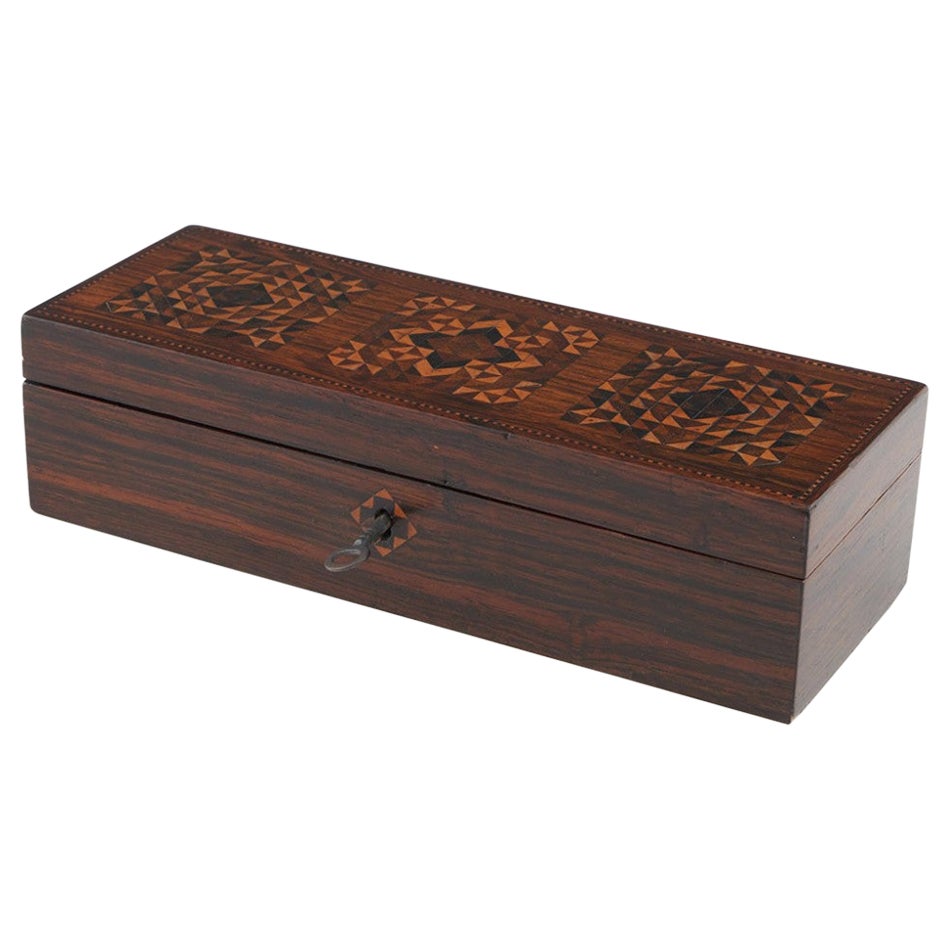Want more images or videos?
Request additional images or videos from the seller
1 of 12
Regency Tunbridge Ware Sewing Box
About the Item
Fitted Interior & Silver Handles
From our Tunbridge Ware collection, we are delighted to offer this Tunbridge Ware Sewing Box. The Sewing Box of rectangular form beautifully veneered in Partridge wood edged in crossbanded Tulipwood and Satinwood with Boxwood stringing and stained Sycamore. The lid features a central classical Roman scene with the emperor receiving an offering within a symmetrical border. When opened the Sewing Box reveals the red paper lining and partitioned central removable tray with compartments containing multiple sewing tools including thread reels, a thimble, a pair of prickers, perfume bottles, a pin cushion, thread waxes as well as some tiny storage boxes with sliding lids that can be removed. Below the tray is a storage area for larger tools or yarn. The Tunbridge Ware Sewing Box dates to the Regency period and early 19th century during the reign of the Prince Regent George circa 1815.
The box comes complete with working lock and tasselled key.
Partridge Wood also known as Cabbage wood, is found in South America. It can come in a variety of colours ranging from red-brown, brown to almost black. Partridge wood is similar to rosewood in density and grain tightness. It's a slightly rarer wood due to the difficulty of finishing it cleanly.
Tulipwood is also known as Brazilian Tulipwood, Brazilian Pinkwood and Bahia Rosewood. It is found in South America, mainly Brazil. The colour is warm yellow with streaks or brown-red grain.
Sycamore also known as Harewood is a member of the Maple family, found in Europe. It is light yellow in colour and is often a very clean wood, with a straight, fine grain. The wood is often pippy. However, these pips are usually a very similar colour to the rest of the wood making them hardly visible.
Satinwood is found in India and Sri Lanka. It has a rich golden colour and an almost reflective sheen. Satinwood is traditionally used for high quality furniture.
Boxwood can be found in Europe, Northwest Africa and Southwest Asia. It is a light cream that turns darker to brown when exposed to light. The trees are very small, which is suited to smaller projects like edging or inlay instead of veneers.
Tunbridge Ware, Tunbridge Wells and Tunbridge in Kent, England became popular in the 17th Century for their therapeutic waters. By the 18th century, Tunbridge Wells was a hugely popular Spa resort. Shops and stalls were set up to sell local work of distinction to visitors as souvenirs. Many of the original boxes were decorated with all sorts of different kinds of designs. Many of the Tunbridge boxes had a central image with views of castles, churches, pavilions, animals, country scenes and sometimes people, such as the Young Prince of Wales. These were surrounded by a variety of bandings and panels of floral and geometric designs. Tunbridge Ware items originate from the beautiful spa town of Royal Tunbridge Wells in Kent. We always have a very good selection which showcases the techniques of tessellated mosaic, stick ware, perspective cube mosaic, vandyke and painted pen work. We always have a selection of artworks and pieces which showcase the techniques of tessellated mosaics, stick ware, perspective cube mosaics, vandykes and painted pens.
Regency is an era of British history between 1811 and 1820. The Regency era was initiated by King George III first suffered a debilitating illness in the late 1780s. He relapsed into his mental illness in 1810 and by the Regency Act in 1811 his eldest son George, Prince of Wales, was appointed prince regent to discharge royal functions. When George III died in 1820, the Prince Regent succeeded him as George IV.
Measurements (centimetres) 14 High x 34.5 Wide x 28 Deep
- Creator:Tunbridge Ware (Cabinetmaker)
- Dimensions:Height: 5.5 in (13.97 cm)Width: 13.58 in (34.5 cm)Depth: 11 in (27.94 cm)
- Style:Regency (Of the Period)
- Materials and Techniques:
- Place of Origin:
- Period:
- Date of Manufacture:Circa 1815
- Condition:Wear consistent with age and use.
- Seller Location:Northampton, GB
- Reference Number:
About the Seller
No Reviews Yet
Vetted Seller
These experienced sellers undergo a comprehensive evaluation by our team of in-house experts.
Established in 1998
1stDibs seller since 2023
12 sales on 1stDibs
- ShippingRetrieving quote...Ships From: Northampton, United Kingdom
- Return PolicyA return for this item may be initiated within 14 days of delivery.
More From This SellerView All
- Georgian Tunbridge Ware Folk Art Cottage Sewing BoxBy Tunbridge WareLocated in Northampton, GBTunbridge Ware Folk House Sewing Box From our Sewing Box collection, we are thrilled to offer this Novelty Folk Art Cottage Sewing Box. The box of rectangular form made from Sycamor...Category
Antique Early 1800s British Georgian Decorative Boxes
MaterialsWood, Sycamore
- Brighton Pavilion Tunbridge Ware Sewing CompendiumBy Tunbridge WareLocated in Northampton, GBRare Tunbridge Ware Form Sewing Compendium From our Tunbridge Ware collection, we are delighted to offer this very rare Tunbridge Wear Sewing Compendium. The Sewing Compendium modelled as a tower from the Brighton Pavilion features the iconic minaret turned in Sycamore (aka white wood) and a large globular body with hand-painted details leading to further turned faces and the hand-painted windows upon a stepped base. The Sewing Compendium opens in two locations one just below the first dome revealing a pin cushion and the second just above the windows revealing the Sewing tools including a Tunbridge Ware thimble and bobbin. The Tunbridge Ware Sewing Compendium dates to the Georgian era during the reign of George IV circa 1825. Brighton Pavilion, The Royal Pavilion and surrounding gardens are a Grade I listed property and were the former Royal residence located in Brighton, England. It was built in 1787 in three stages as a seaside retreat for George, Prince of Wales who became the Prince Regent in 1811 and then King George IV in 1820. It is built in the Indo-Saracenic style prevalent in India for most of the 19th century. The current appearance of the Pavilion which has various domes and minarets, is the work of architect John Nash, who extended the building starting in 1815. George IV's successors William IV and Victoria also used the Pavilion but Queen Victoria decided that Osborne House should replace the Pavilion as the royal seaside retreat and therefore the Pavilion was sold to the city of Brighton in 1850. Indo-Sarascenic refers to a cross between Indian architecture and Muslim architecture. Minarets means beacon in Arabic. In Islamic religious architecture, the tower from which the faithful are called to prayer five times each day by a muezzin, or crier. Such a tower is connected to a mosque and has one or more balconies or open galleries. The inspiration for the minarets features on the Brighton Pavilion are in homage to these types of finials. John Nash (1752-1835) was one of the most prevalent British architects from the Georgian and Regency periods. He was responsible for the design, in the neoclassical and picturesque styles of many important areas of London. He was financed by the Prince Regent and by the era's most successful property developer, James Burton. Nash's most famous designs were the Brighton Pavilion, Marble Arch and Buckingham Palace. Sycamore is a member of the Maple family, found in Europe. It is light yellow in colour and is often a very clean wood, with a straight, fine grain. The wood is often pippy. However, these pips are usually a very similar colour to the rest of the wood making them hardly visible. Georgian, a period in British history dating from 1714-1837, the Georgian era after the Hanoverian kings George I, George II, George III and George IV. Tunbridge Ware Tunbridge Wells and Tunbridge in Kent, England became popular in the 17th Century for their therapeutic waters. By the 18th century, Tunbridge Wells was a hugely popular Spa resort. Shops and stalls were set up to sell local work of distinction to visitors as souvenirs. Many of the original boxes were decorated with all sorts of different kinds of designs. Many of the Tunbridge boxes...Category
Antique Early 19th Century British George IV Decorative Boxes
MaterialsWood, Sycamore
- Regency Japanned Chinoiserie Sewing CabinetLocated in Northampton, GBRegency Japanned sewing cabinet beautifully decorated with vibrant chinoiserie scenes. The front and top of the Japanned table cabinet has detailed p...Category
Antique 19th Century British Decorative Boxes
MaterialsPaper
- Georgian Satinwood Paper Scroll Sewing BoxLocated in Northampton, GBSatinwood sewing box with rare, unusual oval and quartered panels of paperscroll work to the top. Crossbanded on each side with goncalo alves. The interior is lined with a green ruched silk and matching paper and contains a removable tray holding a collection of bone sewing tools. This antique satinwood paper scroll...Category
Antique Early 19th Century British Decorative Boxes
MaterialsSilk, Satinwood, Paper
- 19th Century Antique Chinese Sewing BoxLocated in Northampton, GBThis Antique Sewing box is octagonal-shaped with a rolled top, it features a hinged lid whilst standing on four carved winged Dragon's feet. The border on this Sewing Box is beautifully decorated with intricately worked foliate gilt borders and it shows various scenes of Chinese figures in pavilion gardens. The chinoiserie gold decoration adorns the exterior of the piece with decorative scenes of small Chinese figures in pavilion gardens. The interior houses a removable tray with eighteen compartments containing various bone sewing supplies. Two compartments in the interior have lids that match the beautiful chinoiserie decoration on the exterior of the box. There is a lockable drawer at the front of the box which contains six compartments. In one of the boxes, the lid is hinged and beautifully decorated to complement the box's exterior. An elegant tasselled key that operates a fully operational lock is included with this wonderful Chinoiserie Sewing Box.Category
Antique Mid-19th Century Chinese Decorative Boxes
MaterialsLacquer
- Georgian Rare Pair of Inlaid Rosewood Sewing BoxesLocated in Northampton, GBRosewood and Mother of Pearl From our Sewing Box collection, we are thrilled to offer this pair of Georgian Rosewood Sewing Boxes. The Sewing Boxes of rectangular shape veneered in ...Category
Antique Early 19th Century British William IV Decorative Boxes
MaterialsWood
You May Also Like
- Tunbridge Ware Sewing Box c1840By Tunbridge WareLocated in Tunbridge Wells, GBHeading : Tunbridge ware sewing box Date : c1840 Period : Victoria Origin : Tunbridge Wells, Kent Decoration : Central perspective cube patte...Category
Antique 1840s British Victorian Decorative Boxes
MaterialsWood
- Tunbridge Ware Glove Box c1860By Tunbridge WareLocated in Tunbridge Wells, GBHeading : Tunbridge ware glove box Date : c1860 Period : Victoria Origin : Tunbridge Wells, Kent Decoration : Cover with a berlin woolwork floral mosaic within keylines bordered by v...Category
Antique 1860s British Victorian Decorative Boxes
MaterialsWood
- Tunbridge Ware Jewellery Box c1870By Tunbridge WareLocated in Tunbridge Wells, GBHeading : Tunbridge ware jewellery box Date : c1870 Period : Victoria Origin : Tunbridge Wells, Kent Decoration : Pillow top cover with central floral mosaic within keylines. Cover b...Category
Antique 1870s British Victorian Decorative Boxes
MaterialsWood
- Tunbridge Ware Glove Box c1840By Tunbridge WareLocated in Tunbridge Wells, GBHeading : Tunbridge ware glove box Date : c1840 Period : Victoria Origin : Tunbridge Wells, Kent Decoration : Three geometric stickware designs to cover with keyline border. Internal...Category
Antique 1840s British Early Victorian Decorative Boxes
MaterialsWood
- Robert Vorley Tunbridge Ware Jewellery Box 2022By Tunbridge WareLocated in Tunbridge Wells, GBHeading : Robert Vorley Tunbridge ware box Date : 2022 Period : Elizabeth II Origin : Essex Decoration : Central tesselated Painted Lady butterfly w...Category
2010s British Victorian Jewelry Boxes
MaterialsWood
- Pillow Topped Tunbridge Ware Glove Box c1880By Tunbridge WareLocated in Tunbridge Wells, GBHeading : Pillow topped Tunbridge ware glove box Date : c1880 Period : Victoria Origin : Tunbridge Wells, Kent Decoration : Central floral mosaic wth a foliate mosaic border within k...Category
Antique 1880s British Victorian Decorative Boxes
MaterialsWood
Recently Viewed
View AllMore Ways To Browse
Dior Cabbage
Portmeirion Botanic Garden
Onyx Cigarette
Box With Garland
Thomas Pistor
Bear Black Compact
Russian Paper Mache Lacquer Box
Scottish Tartan Box
Wooden Box Danish
Pill Container
Mother Of Pearl Mother Of Pearl Furniture
Wedgwood Cut Steel
Wood And Brass Spice Box
Wooden Inlay Reuge
1914 Bronze And Milk Glass
1960 Teak Hinged Jewelry Box
20th Century Coconut Elephant Box
Ancient Roman Trinket Box
